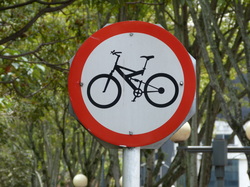 Cicloruta sign in Bogotá
Cicloruta sign in Bogotá In most cities today, a minority has a stranglehold on the space allocated to transport. This minority (and it is a minority in most cities of the world) is city dwellers who use cars. Big-city space is scarce, and with one person in a car taking up an area that could accommodate dozens in a bus or streetcar, or maybe 6 on bicycles, cars tend to overwhelm urban infrastructure and rob everyone of quality mobility.
Large cities around the world are looking for solutions to the mobility problem, and those that have succeeded have almost invariably placed limits on the automobile. These successful cities have built accessible and efficient public transport systems. Some have gone a step further, making bicycling a safe and viable option for all urban residents, revolutionizing urban life in unexpectedly nice ways. Innovative street design, incorporating bicycle paths, is central to the plans of any city aiming for the highest quality of urban life.
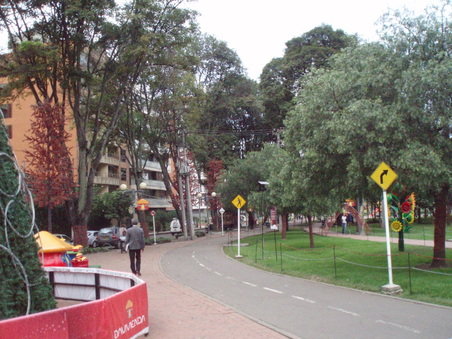 A bike path wending it's way through Parque el Virrey in my neighborhood in Bogotá.
A bike path wending it's way through Parque el Virrey in my neighborhood in Bogotá. The development of bicycle infrastructure (but not bicycle usage) tends to closely follow socioeconomic indicators such as high income and high education. The countries best known for providing excellent paths for bicyclists include the Netherlands, Denmark, and Germany. Cities with a similar reputation include Montreal, Portland, Perth, Barcelona, and even New York as of late. But one city ranked near the top for its biking infrastructure is a bit out of place in this elite group of wealthy countries and cities: Bogotá, the capital of Colombia. Bogotá consistently ranks among the top ten cities globally for biking, and it provides a model for many other cities in the developing world. There's a fascinating history behind Bogotá's unlikely rise, and I recommend you take a look at Martin Herrndorf's blog on this topic here.
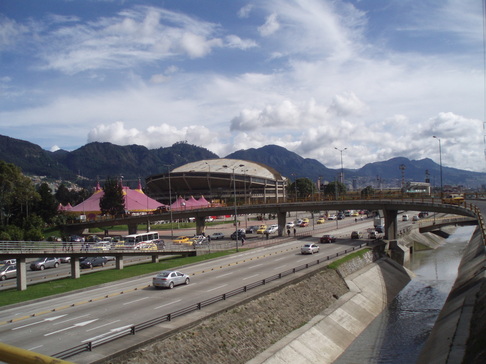 View of the Coliseo El Campin from a pedestrian/bicycle bridge.
View of the Coliseo El Campin from a pedestrian/bicycle bridge. The paths here are used for leisure and exercise, general transport, and have a surprising number of people delivering goods of great variety - from hot meals to metal piping. I could just as easily exchange the word 'people' with 'men', however, when describing users of the ciclorutas. My impression is that male bikers greatly outnumber female bikers, especially on weekdays. I can only speculate as to why (maybe security concerns or an idea that it's not a feminine way to get around). A recent article in Transportation Alternatives gives some answers to a similar question in New York City.
Finally let me clarify that despite its extensiveness the cicloruta system in Bogotá is not, in my observations, used like systems in Amsterdam and Copenhagen as a primary mode of transport for office workers. But this is a topic for another posting.
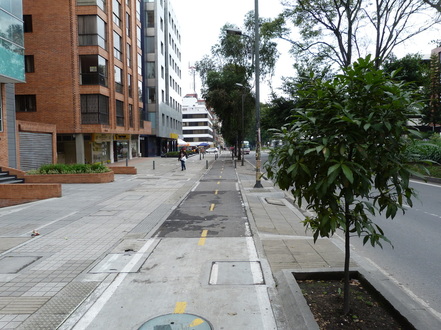 A bicycle path along Carrera 11 with beautiful newly planted trees.
A bicycle path along Carrera 11 with beautiful newly planted trees. 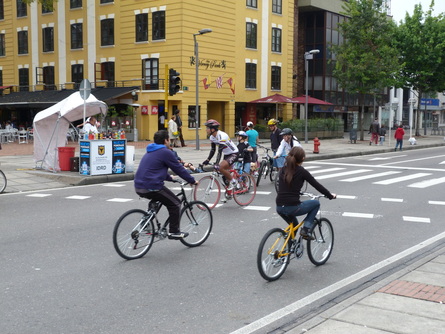 Ciclovia on Carrera 15 at Calle 87.
Ciclovia on Carrera 15 at Calle 87. 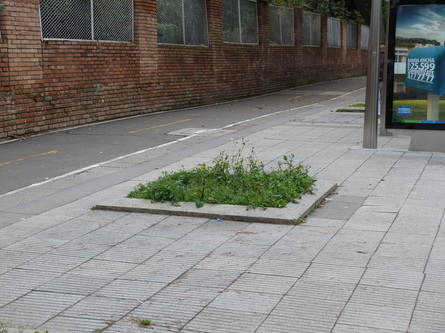 Empty spaces waiting for trees along a Bogotá bike path.
Empty spaces waiting for trees along a Bogotá bike path. There are also many un-pruned trees that obstruct bicyclists. It's not uncommon to have to duck as you ride to pass through some areas. I envision a project wherein CitiNature will help train volunteer pruners to do this job, as is done in New York City.
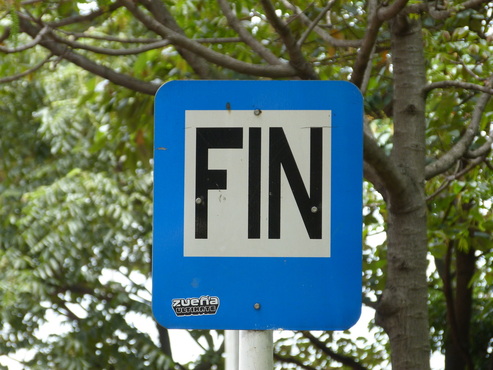 A sign marking the end of a cicloruta.
A sign marking the end of a cicloruta. To purchase a bike in Bogotá and start making a difference, check out Martin's excellent recommendations.

 RSS Feed
RSS Feed

